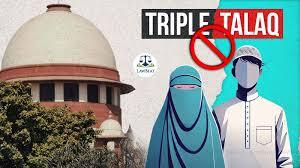The Supreme Court of India’s landmark judgment in Shayara Bano v. Union of India (2017), which declared the practice of instant triple talaq (talaq-e-biddat) unconstitutional, was hailed as a historic victory for Muslim women and a step toward gender justice. But in the years since the verdict and the subsequent enactment of the Muslim Women (Protection of Rights on Marriage) Act, 2019, questions remain: Was this truly a transformative legal reform, or merely a symbolic gesture without tangible impact on the ground?
Understanding Triple Talaq
Triple talaq, or talaq-e-biddat, is a form of Islamic divorce practiced by some Sunni Muslims, wherein a husband could unilaterally divorce his wife by uttering “talaq” three times in one sitting, orally or even via text or email. The practice, considered arbitrary and instant, left women without financial security, legal recourse, or time for reconciliation.
While many Islamic scholars and jurists criticized triple talaq as un-Islamic and a deviation from Quranic procedure, it continued to be prevalent in India, affecting the lives of countless Muslim women.
The Shayara Bano Case: A Legal Turning Point
The Shayara Bano case brought the issue of triple talaq into the national spotlight. Shayara Bano, who was divorced by her husband through talaq-e-biddat, challenged the constitutionality of the practice, arguing that it violated her fundamental rights under Articles 14 (equality before law), 15 (non-discrimination), 21 (right to life and personal liberty), and 25 (freedom of religion) of the Constitution.
The five-judge Constitution Bench of the Supreme Court delivered a 3:2 majority judgment in August 2017. Three judges—Justice Kurian Joseph, Justice Rohinton F. Nariman, and Justice U.U. Lalit—declared instant triple talaq unconstitutional and arbitrary. The other two, Chief Justice J.S. Khehar and Justice S. Abdul Nazeer, dissented, suggesting a temporary stay and allowing Parliament to frame a law.
The majority held that triple talaq violated Article 14 and lacked legal sanctity. Justice Kurian Joseph went further to declare that talaq-e-biddat is not essential to Islamic practice and is therefore not protected under Article 25.
The Legislative Follow-Up
Following the judgment, the government introduced the Muslim Women (Protection of Rights on Marriage) Bill, which was passed in 2019. The Act criminalized the practice of instant triple talaq, making it a cognizable and non-bailable offence punishable with up to three years of imprisonment.
The Act drew mixed reactions. While many lauded it as a long-overdue protection for Muslim women, others criticized the criminalization aspect, pointing out that it could be misused or cause undue hardship to Muslim men and families.
A Legal Milestone for Gender Justice
The judgment and the subsequent legislation undoubtedly mark a significant legal development in India’s journey toward gender equality and secular justice. Several factors contribute to its recognition as a legal milestone:
- Recognition of Women’s Rights: The judgment acknowledged the plight of Muslim women who were often left without recourse due to the sudden nature of triple talaq. By striking down the practice, the Court sent a powerful message about the importance of individual dignity, equality, and non-discrimination.
- Judicial Activism in Personal Law: Indian courts have historically been hesitant to interfere with religious personal laws. The triple talaq verdict broke this trend by asserting that personal laws must also conform to constitutional principles of justice and equality.
- Precedent for Future Reform: The case sets a precedent for examining other discriminatory practices within personal laws, potentially paving the way for reforms in inheritance, maintenance, and guardianship laws across religious communities.
Or a Mere Symbolic Gesture?
Despite its promise, critics argue that the triple talaq verdict and the 2019 law are largely symbolic and have not translated into significant change at the grassroots level.
- Limited Impact on Practice: Reports suggest that instances of triple talaq continue, albeit in reduced numbers. Awareness among women about their rights remains limited, especially in rural and conservative areas, making enforcement difficult.
- Criminalization Without Safeguards: Criminalizing a civil act like divorce raises concerns. The Act does not adequately address the maintenance of the wife or the custody of children post-divorce. Moreover, by imprisoning the husband, it may jeopardize the financial security of the family.
- Political Undertones: Critics claim that the verdict and the subsequent legislation were used to polarize communities, presenting the ruling party as a champion of women’s rights while subtly targeting Muslim personal laws. This has led to mistrust among sections of the Muslim community, undermining the inclusivity that genuine reform demands.
- Lack of Broader Reform in Personal Law: The focus on triple talaq has not led to a comprehensive review of other gender-discriminatory practices in Muslim personal law or other religious personal laws. Polygamy, child marriage, and unequal inheritance rights continue to exist.
The Way Forward
For the triple talaq judgment to become more than just a symbolic victory, concerted steps are necessary:
- Awareness and Legal Literacy: There must be widespread campaigns, especially among Muslim women, to raise awareness of their legal rights. NGOs, civil society, and legal aid organizations must play a proactive role.
- Reform Personal Laws Across the Board: India needs a broader discussion on the Uniform Civil Code or at least gender-just reforms across all personal laws. The aim should not be uniformity for its own sake but equality and dignity for all citizens.
- Judicial Sensitivity and Balanced Legislation: Future laws must strike a balance between civil remedies and criminal consequences, ensuring that justice does not come at the cost of social disruption.
Conclusion
The triple talaq verdict is undoubtedly a legal milestone—one that affirms the Constitution’s promise of equality and dignity for all, including those governed by personal laws. But legal judgments, however historic, are not silver bullets. Real transformation requires social change, awareness, and sustained political will.
Whether the judgment remains a symbolic gesture or matures into a catalyst for deeper reform depends on how effectively we build on its promise. In the battle between law and custom, law may win the verdict, but only society can deliver the justice.
Contributed by : Aastha Shrivastav (Intern)

